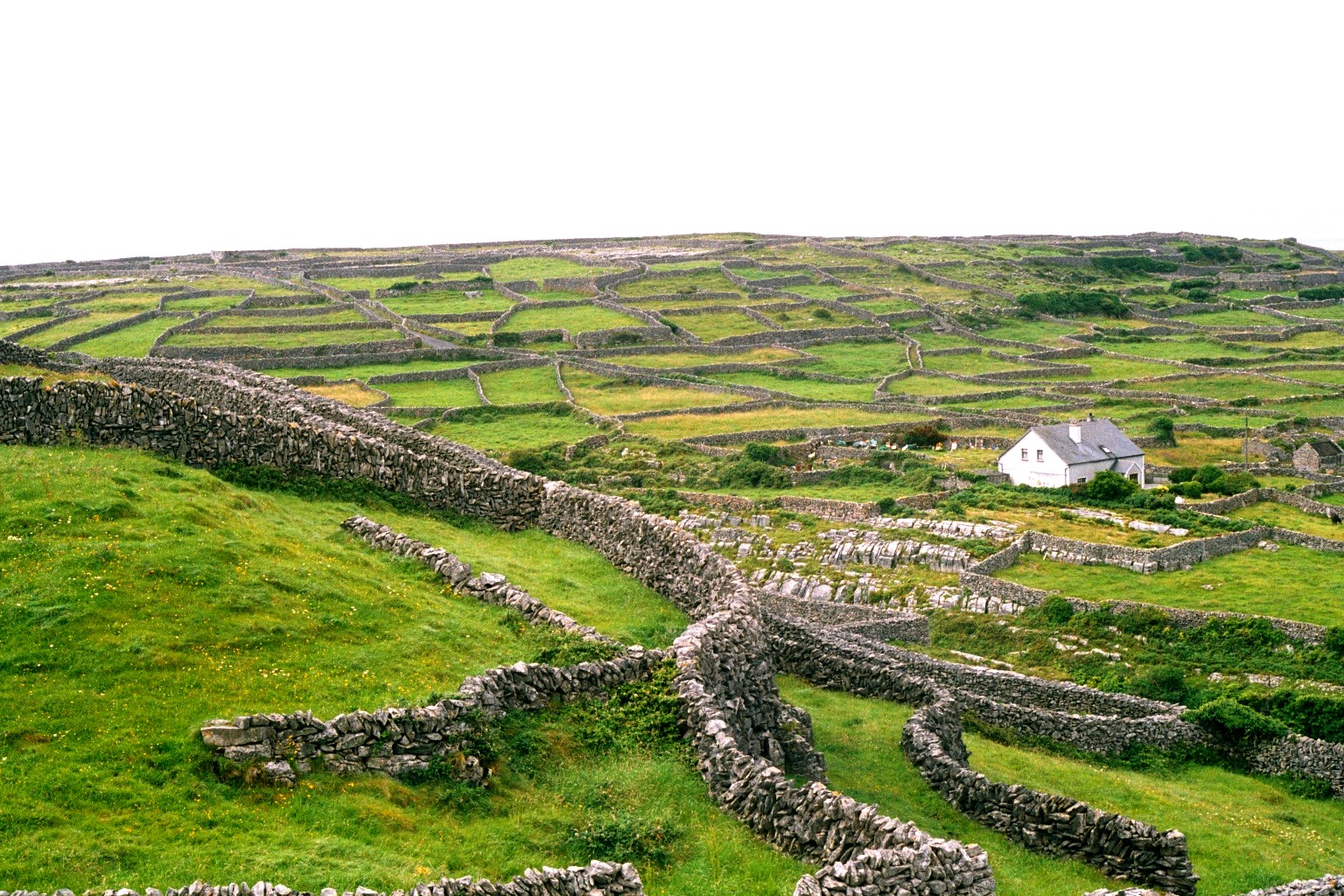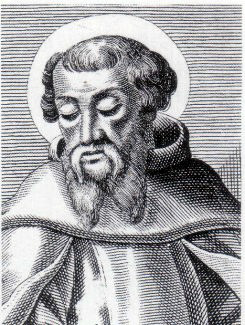|
St. Gobnet's Church
St. Gobnet's Church is a medieval church and National Monument (Ireland), National Monument located on Inisheer, Ireland. Location St. Gobnet's Church is located in the northern part of Inisheer, in the Aran Islands. History The site is believed to have been in use since the 6th century. According to traditional tales, Saint Gobnait fled from County Clare to Inisheer to escape a family feud. Later, an angel appeared to her and told her to return to the mainland and go south until she saw nine white deer; she settled at Ballyvourney and built a religious community. The remains of her beehive hut are said to be on Inisheer. The stone church was built in the 11th or 12th century. The church was excavated in 1980 by W. Walsh. Church A rectangular stone church. The remains of a beehive hut are visible; there are also two bullaun stones and three raised stone slabs. References {{Reflist Aran Islands Former churches in County Galway Archaeological sites in County Galway Nationa ... [...More Info...] [...Related Items...] OR: [Wikipedia] [Google] [Baidu] |
Inisheer
Inisheer ( ga, Inis Oírr , or ) is the smallest and most easterly of the three Aran Islands in Galway Bay, Republic of Ireland, Ireland. With 281 residents as of the 2016 census, it is second-most populous of the Arans. Caomhán of Inisheer, Caomhán of Inis Oírr is the island's patron saint. There are five small settlements: Baile Thiar, Chapeltown (Baile an tSéipéil), Castle Village (Baile an Chaisleáin), Baile an Fhormna and Baile an Lorgain. Name The island was originally called ''Árainn Airthir'', and later ''Inis Oirthir'', which are thought to mean "eastern Aran" and "eastern island" respectively. (see scanned records) The second element is also found in the names Inishsirrer and Orior Lower, Orior. According to Séamas Ó Murchú, the current official name, , was brought into use by the Ordnance Survey Ireland. He says it may be a compromise between and the traditional local name . Geology and geography The island is geologically an extension of The Burre ... [...More Info...] [...Related Items...] OR: [Wikipedia] [Google] [Baidu] |
County Galway
"Righteousness and Justice" , anthem = () , image_map = Island of Ireland location map Galway.svg , map_caption = Location in Ireland , area_footnotes = , area_total_km2 = 6151 , area_rank = 2nd , seat_type = County town , seat = Galway , population_total = 276451 , population_density_km2 = auto , population_rank = 5th , population_as_of = 2022 , population_footnotes = , leader_title = Local authorities , leader_name = County Council and City Council , leader_title2 = Dáil constituency , leader_name2 = , leader_title3 = EP constituency , leader_name3 = Midlands–North-West , subdivision_type = Country , subdivision_name = Ireland , subdivision_type1 = Province , subdivision_name1 = Connacht , subdivision ... [...More Info...] [...Related Items...] OR: [Wikipedia] [Google] [Baidu] |
Pre-Reformation Catholic
The history of the Catholic Church is the formation, events, and historical development of the Catholic Church through time. The tradition of the Catholic Church claims the Catholic Church began with Jesus Christ and his teachings; the Catholic tradition considers that the Catholic Church is a continuation of the early Christian community established by the Disciples of Jesus. The Church considers its bishops to be the successors to Jesus's apostles and the Church's leader, the Bishop of Rome (also known as the Pope), to be the sole successor to Saint Peter who ministered in Rome in the first century AD after his appointment by Jesus as head of the Church.Hitchcock, ''Geography of Religion'' (2004), p. 281, quote: "Some (Christian communities) had been evangelized by Peter, the disciple Jesus designated as the founder of His church. Once the position was institutionalized, historians looked back and recognized Peter as the first pope of the Christian church in Rome"Norman, ' ... [...More Info...] [...Related Items...] OR: [Wikipedia] [Google] [Baidu] |
Gobnait
Saint Gobnait (?), also known as Gobnat or Mo Gobnat or Abigail or Deborah, is the name of a medieval, female Irish saint whose church was Móin Mór, later Bairnech, in the village of Ballyvourney ( ga, Baile Bhuirne), County Cork in Ireland.Johnston, "Munster, saints of (act. ''c''.450–''c''.700)." She was associated with the Múscraige and her church and convent lay on the borders between the Múscraige Mittine and Eóganacht Locha Léin. Her feast day is February 11. Sources No hagiographical ''Life'' is known to have described her life and miracles, but she appears in the ''Life'' of her senior companion St Abbán moccu Corbmaic, written in the early thirteenth century but known only through later recensions. Saint Finbarr's ''Life'' implies that Gobnait's church belonged to Finbarr's foundation at Cork by alleging that it was not founded by her, but by one of his disciples. In spite of this, Gobnait's cult continued to thrive here and the ruins of a medieval church dedi ... [...More Info...] [...Related Items...] OR: [Wikipedia] [Google] [Baidu] |
Roman Catholic Archdiocese Of Tuam
The Archdiocese of Tuam ( ; ga, Ard-Deoise Thuama) is an ecclesiastical territory or archdiocese of the Catholic Church ( particularly the Roman Catholic or Latin Church) located in western Ireland. The archdiocese is led by the Archbishop of Tuam, who serves as pastor of the mother church, the Cathedral of the Assumption and Metropolitan of the Metropolitan Province of Tuam. According to tradition, the "Diocese of Tuam" was established in the 6th century by St. Jarlath. The ecclesiastical province, roughly co-extensive with the secular province of Connacht, was created in 1152 by the Synod of Kells. The incumbent Ordinary is Francis Duffy. Province and geographic remit The Province of Tuam, is one of four ecclesiastical provinces that together form the Roman Catholic Church in Ireland; the other provinces are Armagh, Dublin and Cashel. The geographical remit of the province is confined to the Republic of Ireland alone. The suffragan sees of the Province are: :* Achonry ... [...More Info...] [...Related Items...] OR: [Wikipedia] [Google] [Baidu] |
Aran Islands
The Aran Islands ( ; gle, Oileáin Árann, ) or The Arans (''na hÁrainneacha'' ) are a group of three islands at the mouth of Galway Bay, off the west coast of Republic of Ireland, Ireland, with a total area around . They constitute the historic barony (Ireland), barony of Aran in County Galway. From west to east, the islands are: Inishmore (''Árainn'' / ''Inis Mór''), which is the largest; Inishmaan (''Inis Meáin''), the second-largest; and Inisheer (''Inis Oírr''), the smallest. There are also several islets. The population of 1,226 (as of 2016) primarily speak Irish language, Irish, the language of local placenames, making the islands a part of the Gaeltacht. Most islanders are also fluent or proficient in Hiberno-English, English. The population has steadily declined from around 3,500 in 1841. Location and access The approaches to the bay between the Aran Islands and the mainland are: * North Sound''An Súnda ó Thuaidh'' (more accurately ''Bealach Locha Lurgan'') l ... [...More Info...] [...Related Items...] OR: [Wikipedia] [Google] [Baidu] |
County Clare
County Clare ( ga, Contae an Chláir) is a county in Ireland, in the Southern Region and the province of Munster, bordered on the west by the Atlantic Ocean. Clare County Council is the local authority. The county had a population of 118,817 at the 2016 census. The county town and largest settlement is Ennis. Geography and subdivisions Clare is north-west of the River Shannon covering a total area of . Clare is the seventh largest of Ireland's 32 traditional counties in area and the 19th largest in terms of population. It is bordered by two counties in Munster and one county in Connacht: County Limerick to the south, County Tipperary to the east and County Galway to the north. Clare's nickname is ''the Banner County''. Baronies, parishes and townlands The county is divided into the baronies of Bunratty Lower, Bunratty Upper, Burren, Clonderalaw, Corcomroe, Ibrickan, Inchiquin, Islands, Moyarta, Tulla Lower and Tulla Upper. These in turn are divided into civil parishes, ... [...More Info...] [...Related Items...] OR: [Wikipedia] [Google] [Baidu] |
Angel
In various theistic religious traditions an angel is a supernatural spiritual being who serves God. Abrahamic religions often depict angels as benevolent celestial intermediaries between God (or Heaven) and humanity. Other roles include protectors and guides for humans, and servants of God. Abrahamic religions describe angelic hierarchies, which vary by religion and sect. Some angels have specific names (such as Gabriel or Michael) or titles (such as seraph or archangel). Those expelled from Heaven are called fallen angels, distinct from the heavenly host. Angels in art are usually shaped like humans of extraordinary beauty. They are often identified in Christian artwork with bird wings, halos, and divine light. Etymology The word ''angel'' arrives in modern English from Old English ''engel'' (with a hard ''g'') and the Old French ''angele''. Both of these derive from Late Latin ''angelus'', which in turn was borrowed from Late Greek ''angelos'' (literally "messenge ... [...More Info...] [...Related Items...] OR: [Wikipedia] [Google] [Baidu] |
Beehive Hut
A beehive is an enclosed structure in which some honey bee species of the subgenus '' Apis'' live and raise their young. Though the word ''beehive'' is commonly used to describe the nest of any bee colony, scientific and professional literature distinguishes ''nest'' from ''hive''. ''Nest'' is used to discuss colonies that house themselves in natural or artificial cavities or are hanging and exposed. ''Hive'' is used to describe an artificial/man-made structure to house a honey bee nest. Several species of ''Apis'' live in colonies, but for honey production the western honey bee (''Apis mellifera'') and the eastern honey bee (''Apis cerana'') are the main species kept in hives. The nest's internal structure is a densely packed group of hexagonal prismatic cells made of beeswax, called a honeycomb. The bees use the cells to store food (honey and pollen) and to house the brood (eggs, larvae, and pupae). Beehives serve several purposes: production of honey, pollination of nearby c ... [...More Info...] [...Related Items...] OR: [Wikipedia] [Google] [Baidu] |
Cill Gobnait With Fort In Background
Cill or CILL may refer to: * Cill or sill, in water navigation, a horizontal ledge in a lock * Continental Indoor Lacrosse League The Box Lacrosse League (BLL) was a senior men's semi-professional box lacrosse league in the United States. In its final year, the league consisted of five teams with a geographical footprint centered on the Midwestern United States, Midwest reg ..., a senior men's box lacrosse league in the United States See also * Sill (other) {{disambiguation ... [...More Info...] [...Related Items...] OR: [Wikipedia] [Google] [Baidu] |
Bullaun
A bullaun ( ga, bullán; from a word cognate with "bowl" and French ''bol'') is the term used for the depression in a stone which is often water filled. Natural rounded boulders or pebbles may sit in the bullaun. The size of the bullaun is highly variable and these hemispherical cups hollowed out of a rock may come as singles or multiples with the same rock.Pennick, Nigel (1996). ''Celtic Sacred Landscapes''. London: Thames & Hudson. . p. 40. Local folklore often attaches religious or magical significance to bullaun stones, such as the belief that the rainwater collecting in a stone's hollow has healing properties.Anthony Weir, Early Ireland, A Field Guide, Blackstaff Press, 1980, Ritual use of some bullaun stones continued well into the Christian period and many are found in association with early churches, such as the 'Deer' Stone at Glendalough, County Wicklow. The example at St Brigit's Stone, County Cavan, still has its 'cure' or 'curse' stones. These would be used by turn ... [...More Info...] [...Related Items...] OR: [Wikipedia] [Google] [Baidu] |






